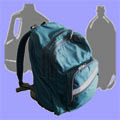|
|
How Do We Get From Bonds to Bags, Bottles,
and Backpacks? Module written by Karen Harding and Sharon Anthony |
Session 1: How hefty is that bag?
Introduction
Exploration 1A: How hefty is that bag?
Exploration 1B: What is your consultant project?
![]() American Plastics
Council (http://www.plasticsresource.com)
American Plastics
Council (http://www.plasticsresource.com)
Session 2: What are bags and bottles made of?
Lewis Structures and Chemical Notation
Exploration 2A: What polymers are in paper bags?
Exploration 2A: What polymers are in plastic bags?
Exploration 2B: How do chemists draw polymers?
Exploration 2C: Why is it called polyethylene?
Exploration 2D: Shedding light on polymers
![]() Identification
of polymers by infrared spectroscopy
Identification
of polymers by infrared spectroscopy
Session 3: How can plastic bags and milk jugs be the same
polymer?
VSEPR and Hybrid Orbital Bonding Theories
Exploration 3A: How can plastic bags and milk jugs be the same polymer?
Exploration 3B: Can we predict the shapes of monomers using VSEPR theory?
Exploration 3C: Can we predict the shapes of monomers using hybrid orbital
theory?
Exploration 3D: Why is it slimy?
![]() The rise and
demise of slime laboratory
The rise and
demise of slime laboratory
Session 4: How are polymers made?
Polymerization Reactions
Exploration 4A: How is polyethylene made?
Exploration 4B: How is paper made?
Exploration 4C: How can you predict the structure of a polymer?
Exploration 4D: How is nylon made?
Exploration 4E: How are polyesters formed?
Session 5: Does this bag hold water?
Intermolecular Forces
Exploration 5A: Which polymers hold water?
Exploration 5B: Why do some polymers hold water while others do not?
Exploration 5C: How does polarity affect boiling point?
Exploration 5D: Recycling technology: How can we separate plastics?
![]() Laboratory
Laboratory
Session 6: The chemical consultant: What can we do with
our polymer?
Culminating Event
Copyright © 2004 by the trustees of Beloit College and the Regents of the
University of California. This Module has been
developed under the direction of the ChemLinks Coalition, headed by Beloit College,
and the ModularChem Consortium, headed by the University of California at Berkeley.
This material is based upon work supported by the National Science Foundation
grants No. DUE-9455918 and DUE-9455924. Any opinions, findings, and conclusions
or recommendations expressed in this material are those of the authors and do
not necessarily reflect the views of the National Science Foundation, Beloit
College, or the Regents of the University of California.
Published through exclusive license with W.
W. Norton.
How Do We Get from Bonds to Bags, Bottles, and Backpacks? ISBN 0-393-92439-4
Bags, Bottles, and Backpacks | ChemConnections
